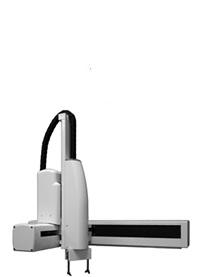
Precise Automation has introduced the PP100 industrial collaborative Cartesian robot. The PP100’s unique mechanical design offers a lower price than most collaborative robots and reduces the overall costs of tabletop applications, according to the company.
This lightweight robot is available with 2 axes (XZ) or 3 axes (XYZ) and an optional Theta and servo gripper. It can be carried by one person, mounted on a table and, by plugging in just an AC power cord and an Ethernet cable, is ready to operate. The controller, power supplies and harnessing are embedded within the robot’s structure, simplifying installations and allowing the PP100 to be mounted above existing work areas and equipment, such as conveyor belts. The collaborative Cartesian design allows for extremely small, cost-saving workcells that have minimal impact on existing production.
Collaborative robots permit the creation of a mixed manufacturing environment where people can enter and efficiently work around robots without the loss of throughput. The PP100’s combination of speed and safety allows its operation at full speed and delivers industrial throughput at safe ISO standard collaborative forces, so operators can move freely around the robot without concerns for their safety or loss of productivity.
The PP100’s simple Cartesian geometry is particularly easy for new users to teach, because any position and move combination is intuitive and possible. In addition, many collaborative robots use a programming environment with limited features to simplify setup for new users. Precise Automation’s collaborative robots offer the flexibility of both an easy-to-use, web-based interface, as well as an optional advanced programming environment as capable as any industrial robot. The easy to use Guidance Motion interface is accessible from any web-enabled device and allows technicians or operators to quickly and easily setup and teach the PP100 to perform real work.
Brian Carlisle, CEO of Precise Automation, states: “Until now, the collaborative robot market has been dominated by 6-axis articulated robots. These robots have complex geometries that create large workcells with significant dead space and make it difficult to teach positions. The simple Cartesian geometry of the PP100 is ideal for simple applications, and for adding process modules such as screwdrivers or dispense heads, and for mounting above equipment like conveyor belts. The integrated controls and ability to bridge conveyors allows this robot to be installed in many applications without taking up valuable floor space. Precise’s full line of industrial collaborative robots (SCARA, Cartesian, 6-axis) allows users to choose the right configuration for their application rather than trying to make a 6-axis robot fit into every workcell.”
Contact Details
Related Glossary Terms
- industrial robot
industrial robot
Robot designed for industrial use. Primarily used as a material-handling device but also used for changing tools, assembling parts, and manipulating special tools and measuring devices. Depending on design, an industrial robot can be programmed to perform a task by means of a controller, or it can be “walked” through the required movements by utilizing a digitizing system that translates movements into commands that the robot can be “taught.” See robot; teaching pendant.
